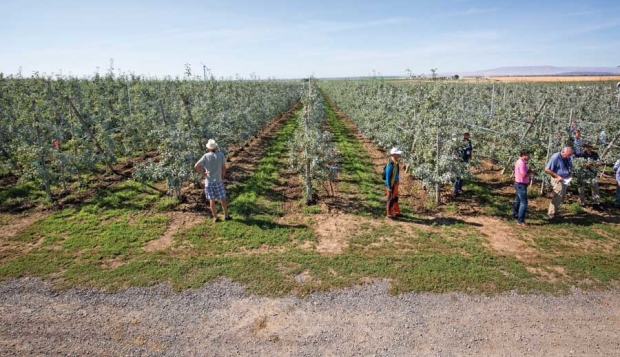
A Stemilt orchard managed by Dale Goldy is planted using a tall spindle system. The orchard was part of the first day of the IFTA Washington tour on July 15, 2015. (TJ Mullinax/Good Fruit Grower)
—Trees are planted at densities of 1,000 to 1,500 trees per acre (typically 3 or 4 feet between trees and 11 to 12 feet between rows).
—Precocious dwarfing rootstocks are used because early cropping is essential to pay for establishment costs and help control tree vigor.
—Highly feathered nursery trees are used. Transplant shock caused by a high top-to-root ratio helps keep trees within the tight spacing and contributes to fruit bud differentiation in the year of planting.
—Minimal pruning is done at planting and is limited to removal of a few of the larger branches, generally those that are more than half the diameter of the leader.
—Upright scaffold branches are devigorated by bending.
—Scaffold limbs are removed as they become too large for the space, leaving 2-inch stubs for renewal,
—Although there are no permanent branches in the standard tall-spindle system, Dale Goldy at Stemilt believes that to get tree vigor low enough for high quality fruit production, some limbs need to be considered permanent, particularly with vigor-sensitive varieties like Honeycrisp.
With low vigor, new limbs don’t grow to refill the space, so it is important to establish balanced limb size early in the life of the tree when you start to think that the limbs are possibly permanent, he says.
– by Geraldine Warner






Leave A Comment